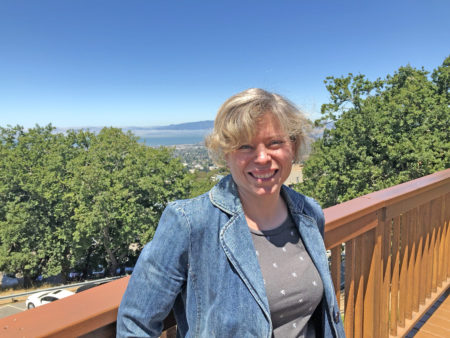 Elaine DiMasi joined the ALS-U Project two months ago, bringing her expertise in both beamline science and project management. Find out why she’s known as the BOSS.
Elaine DiMasi joined the ALS-U Project two months ago, bringing her expertise in both beamline science and project management. Find out why she’s known as the BOSS.
What is your role in the ALS-U Project?
I am the system lead for the beamlines and optical systems. The acronym they used for that is BOSS, so my first email to the group was, “Hi, new BOSS lady here!” We take care of changes to the beamlines for the ALS-U Project. When we upgrade the accelerator ring, source points for bending-magnet beamlines will move. We’ll build two new insertion-device beamlines, substantially upgrade two insertion-device beamlines, and we’re looking into what the existing beamlines will need to survive the upgrade.
When you build a beamline, there are certain technical requirements. Then you ask—how do we make that happen, how long will it take, what will it cost, and what are all the risks? The artistry of it is that, when people are thinking about their science, they’re not necessarily thinking about all the requirements in that kind of detail. Quite a few people in the experimental community have experience building beamlines, designing optics, and being creative. But, when you’re trying to coordinate something as large as an accelerator upgrade, there needs to be a different set of tools to get everybody working together.
I’ve been a member of this community broadly for a long time, so joining Berkeley Lab is kind of like a homecoming. I was on sabbatical here in 2010 to 2011, and so everybody has given me a really big welcome, and I appreciate and enjoy that very much.
What did you do before you came to Berkeley Lab?
At Brookhaven, I worked for 21 years as a scientist based around the synchrotron. I started right out of grad school and got introduced to x-ray scattering at NSLS. I developed instrumentation at a couple facilities, including the Advanced Photon Source. Later, I was part of the NSLS-II project to build an insertion-device beamline. During those six years, I learned about what it means to run a project.
Quite often, after a job like that, the scientists’ light at the end of the tunnel is to get to go back to research. For me, the light at the end of the tunnel was—what’s the next project? And this job became available at ALS-U about two years after I finished my Brookhaven one. In between there and here I actually took some classwork at the Stony Brook University Center for Corporate Education to get a project management certification. So, I’m really happy to be part of the project team here. I promised the team that I’d be bilingual—I would be able to speak project and I’d be able to speak beamline.
What are some of your goals for your work with the project?
For project milestones, my personal wish is that we execute them gracefully and we don’t make it look like a struggle. You know, that we get a lot of buy-in for the decisions. I try to spend time with the ALS side of the house. We’re all going to be one facility in just a few years, so the beamline and user community needs to see that there’s someone on the project side who’s paying attention and understands what the needs are.
The beamlines are at the front lines with the stakeholders. We don’t upgrade an accelerator unless we can build new beamlines, so my area is at that interface. We are not yet used to the fact that you can see things in three-dimensional space with x-rays. Now, we’ll have sources so bright and so coherent that you retain phase information, and that means a really promising new way of looking at matter.
What do you like to do in your free time?
I brought my dog with me from New York, so walking up and down the Oakland hills is one thing; and, once upon a time, I could play keyboards in a rock band.